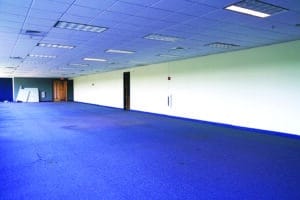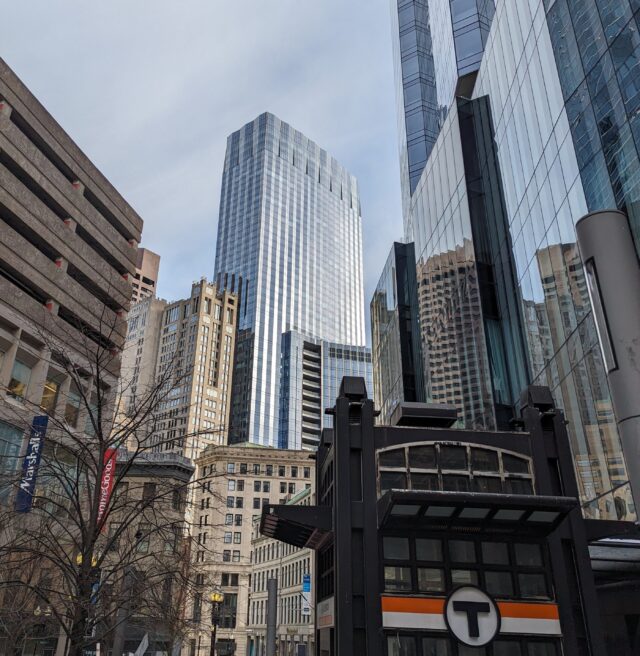
With loan maturity dates looming and tenants scarce, Boston’s class B office building owners may be forced to put off investments in green energy upgrades, experts say. iStock photo
Boston’s office landlords are facing challenges in financing decarbonization investments with emissions reductions deadlines impending amid a weakened office leasing market.
Collapsing commercial office property values in Boston have led to a post-pandemic commercial real estate crisis concentrated in class B and C buildings, with the overall downtown office vacancy rate now over 20 percent and high interest rates predicted to continue into the foreseeable future. With little to no demand for office space, increased labor and construction costs and slowed office leasing velocity, commercial property devaluation is creating difficulties in financing office projects, including decarbonization investments.
“The lenders, who read all the same stories and the data that we have, look at slowdown and leasing velocity, they look at an uptick in vacancy rates, and they say, ‘Why are we going to deploy our capital for an office building in the current environment?’” said Mark Fallon, Director of Research & Strategy at commercial brokerage Hunneman.
Meanwhile, building owners are under pressure to decarbonize and retrofit their office buildings to meet emissions regulations established by Boston and Cambridge.
How Fines Stack Up
Boston has a goal of net zero greenhouse gas emissions by 2050 and a 50 percent reduction from 2005 levels by 2030. The 2019 Carbon Free Boston report said that 86,000 buildings are responsible for about 70 percent of Boston’s total CO2 emissions. Of those 86,000 buildings, the 6,000 non-residential buildings were responsible for nearly 40 percent of total emissions.
To reduce the air pollution and greenhouse gas emissions generated by these large buildings, Boston enacted BERDO, The Building Emissions Reduction and Disclosure Ordinance, in 2014. The law applies to non-residential buildings 20,000 square feet or larger or residential buildings with 15 or more units. Owners of buildings subject to BERDO are required to reduce their emissions in five-year increments through direct reduction of emissions in a building, purchasing renewable energy to offset electrical usage or fines of $234 per metric ton of CO2 a building puts into the atmosphere.
Translating that fine into a typical cost for a class B office building in downtown Boston is complicated by a wide range of variables, like how much CO2 the building already generates above BERDO’s limits.
However, office buildings whose owners have applied to convert to apartments illustrate the fines’ potential impact.
If they had stayed as office buildings, KS Partners’ 286 Washington St. property in Downtown Crossing would have faced an additional $0.55 per square foot in BERDO fines starting in 2035, while the company’s 15 Court St. property would have faced $0.03 per square foot in BERDO fines, according to an online calculator published by the city of Boston.
The cost of operating an average downtown office building in Boston today, including taxes, is roughly $25 per square foot, Fallon estimated.
Amendments to Cambridge’s own Building Energy Use Disclosure Ordinance, or BEUDO, passed in 2023 require large non-residential buildings (over 100,000 square feet) reach net zero greenhouse gas emissions by 2035.
As building owners weigh energy retrofit projects, though, they have to worry about more than just the cost of new HVAC systems or water heaters.
The high cost of environment-focused retrofits can trigger other upgrades like handicap accessibility that aren’t related to carbon at all, increasing the overall cost of the project, Arrowstreet Principal Kate Bubriski said.
“While you might be focused on decarbonization, the cost of that can really build up when you start triggering other building-wide, large upgrades,” she said.

Office buildings with vacant space at the corner of Washington and Bromfield streets in downtown Boston in January 2024. Boston’s office market ended 2023 with a vacancy rate of 15.8 percent, up from 12.5 percent the previous year. Photo by James Sanna | Banker & Tradesman Staff
Investments Could Draw Tenants
Despite these costs, architects, market experts and engineers interviewed for this story said that decarbonization can pay off for owners, and might turn into a necessity amid stiff competition for tenants.
Arrowstreet Principal Jason King said the decarbonization and electrification of office buildings can increase the demand for office spaces.
“The more you can kind of upgrade some of these existing buildings and class B/class C office spaces to have some of that better energy efficiency and building performance and occupant wellness…those are attractive to today’s tenants,” he said.
A 2021 study by Cushman & Wakefield revealed that LEED-certified buildings have lower vacancies than their non-LEED counterparts after COVID-19. LEED-certified buildings have also consistently achieved higher rents than non-LEED counterparts, averaging $4.13 or 11.1 percent higher rent than non-LEED certified buildings.
Bubriski emphasized the growing focus on environmental impact in the renovation of commercial buildings.
“Every project is doing this,” she said. “Especially when we talk about commercial space or lab space…you’re really at the market for what people are looking for.”
Owners that plan to hold onto their buildings for a long time face a simpler calculus, experts say: lower long-term operating costs.
“The first thing that you would typically look at is the upfront cost that you’re paying immediately. But that’s not always representative of the true total cost of ownership,” said Steven Burke, Senior Director of Sustainability at Suffolk Construction.
Instead, he suggests looking at the costs of operation and maintenance. This requires analyzing how frequently the system needs to be serviced and factoring in the avoided fines or risks from a strong environmental performance on the regulatory side.
By investing more in environmental performance, which may involve spending 2 percent to 10 percent more in overall project cost, building owners can protect themselves from future fines.
C-PACE Offers Solutions
Between high interest rates and banks’ skepticism of office properties right now, traditional ways of financing decarbonization projects are hard, experts say. Instead, Commercial Property Assessed Clean Energy (C-PACE) may offer a solution
“C-PACE helps drive down the weighted cost of capital and in some cases reduces the amount of equity required to build a building, which improves returns,” said Michael Doty, senior director of Northeast originations at Nuveen Green Capital.
C-PACE makes it possible for commercial property owners to obtain low-cost, long-term financing for energy efficiency projects. If an existing building is looking to undertake a decarbonization project, C-PACE can fund 100 percent of the project costs as long as the energy savings outweigh the cost in the long-term.
Wendy O’Malley, senior vice president of green finance at MassDevelopment, said that C-PACE is a particularly attractive option for commercial office building owners in a time where they are facing higher costs and a lack of tenants.
“Traditional funding isn’t covering the full cost of construction in many cases, and they need to identify additional financing or funding options that will cover the extra cost for beating a higher standard for the energy design or the building design,” she said. “C-PACE allows more flexibility for developers to utilize it to find the added cost of construction that they’re seeing.”
However, Doty and O’Malley said that the office real estate crisis has made some owners hesitant to invest in their buildings, especially those dealing with large vacancies in a property.
“If you have a real estate crisis, where you don’t have fully leased out space, you don’t have tenants who you can lock in cash flow for future [revenues], you have a tension between investing in your building and making these improvements and getting that return in terms of your tenant occupancy,” O’Malley said.

Boston’s new Winthrop Center skyscraper, certified as the world’s largest Passive House office building, is seen framed by buildings along Franklin Street in Downtown Crossing. Many office tenants are prioritizing buildings with low or no carbon emissions. Photo by James Sanna | Banker & Tradesman Staff
An Unclear Future
Looming maturity dates on loans that may be for more money than a building is now worth and a general lack of affordable financing for commercial office buildings has created a dilemma for building owners, and Boston’s class B building owners haven’t yet found a clear solution to decarbonization mandates.
“In the built environment, particularly in offices I think there’s been a hesitancy to make investments into that space,” Doty said. “And it’s tough to justify a further investment into a property that already is underwater.”
The threat of climate change, Suffolk’s Burke said, does not make the financing problem any less real for “the real estate owner and developer that bought a project in 2014 at $600 million and is selling it for a loss of $200 million today.”
“The real estate community is grappling with real and immediate issues that sort of take priority above everything else,” he said. “I appreciate both sides of the conversation and the difficulty that is presented by trying to do the right thing, but in a difficult time to be doing it.”
Fallon, the Hunneman research director, said owners will weigh whether to retrofit an office property into a green building or just pay the city’s BERDO tax.
“The financing environment hopefully will change which will hopefully free up that kind of flow of funds and make these types of construction projects a little more attainable,” he said. “But I think right now, you’re looking at the economics of what’s cheaper. Instead of having to borrow or put in millions of dollars to retrofit these buildings, should we just pay the overages?”






